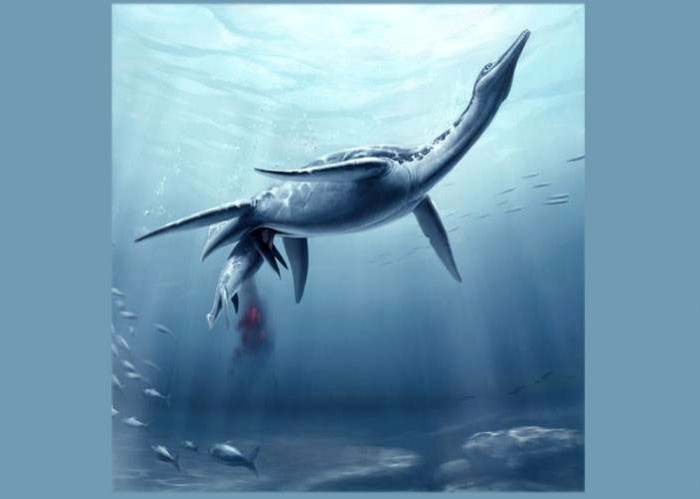Giant Sea Reptile Plesiosaur and Fetus Fossil Discovered: Sea Monster Was a Doting Mammal?

Fossil of a pregnant Plesiosaur, a giant, carnivorous four-flippered reptile that roamed the world's oceans in the Mesozoic Era, together with that of a fetus nearly intact, have been discovered by scientists, confirming beliefs that the sea monster and the modern day dolphins and whales have a lot in common.
The 15 feet-plus long fossil, which was excavated from a ranch in Kansas two decades ago and currently is in the care of Los Angeles County Natural History Museum, has astounded researchers, who realized recently that the bones they saw were of two separate animals and not one - an adult Plesiosaur and probably a fetus.
The study's authors are certain that the bones, which are estimated to be between 72 million and 78 million years old, were that of a mother and (an unborn) baby and the smaller animal wasn't eaten by the larger one because there was no evidence of bite marks on the bones of the smaller animal. Moreover, the soft immature skeleton of the smaller animal suggested that it hadn't even developed fully and was probably a fetus that grew inside the bigger animal.
According to the study published in Aug. 12 issue of Science, the pregnant Plesiosaur was probably a caring mother, like any mammal and this is the first time that viviparity has been found in the Plesiosaur.
"Quantitative analysis indicates that plesiosaurs gave birth to large, probably single progeny," and like many marine mammals, Plesiosaurs may have exhibited "sociality and maternal care," the abstract of the article read.
The research finally throws light on how Plesiosaurs reproduced. For over 200 years, palaeontologists have debated on how these colossal cretaceous animals reproduced and many believed that they probably gave birth to live young and didn;t lay eggs like other reptiles.
The study not only confirms the belief but also suggests that the giant creature gave birth to only one young at a time, very much like the giant mammals of today - whales and elephants - do.
"They give birth to one big baby instead of a lot of little babies," the study's lead author Frank O'Keefe, an associate professor in the Biology Department at Marshall University, said.
According to O'Keefe, it is highly likely that Plesiosaurs were doting parents as they gave birth to one young at a time and could have even formed social groups to tend to their youngs.
"Many of the animals alive today that give birth to large, single young are social and have maternal care," O'Keefe said. "We speculate that plesiosaurs may have exhibited similar behaviors, making their social lives more similar to those of modern dolphins than other reptiles."
However, more study is needed, O'Keefe said to confirm the belief and this is where difficulty lies because studying the behaviour of ancient marine creatures is not at all easy.
"When you get right down to it, behavior doesn't fossilize, so we are stuck trying make these inferences using modern animals where we can observe their behavior," he explained.
© Copyright IBTimes 2025. All rights reserved.



















